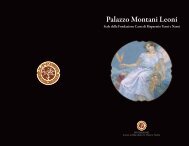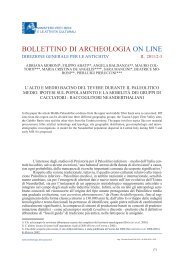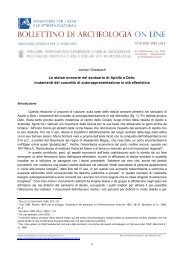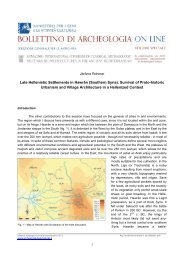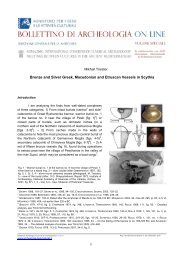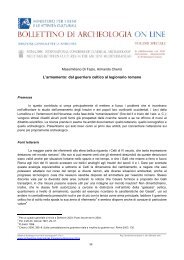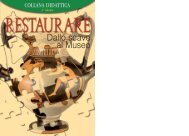The Northern Origin of the Melon Coiffure in Classical Greece
The Northern Origin of the Melon Coiffure in Classical Greece
The Northern Origin of the Melon Coiffure in Classical Greece
You also want an ePaper? Increase the reach of your titles
YUMPU automatically turns print PDFs into web optimized ePapers that Google loves.
E. Lopes – <strong>The</strong> <strong>Nor<strong>the</strong>rn</strong> <strong>Orig<strong>in</strong></strong> <strong>of</strong> <strong>the</strong> <strong>Melon</strong> <strong>Coiffure</strong> <strong>in</strong> <strong>Classical</strong> <strong>Greece</strong><br />
Fig. 18 - Female hair. Tomis, nor<strong>the</strong>rn necropolis<br />
(after CANARACHE 1967).<br />
Bollett<strong>in</strong>o di Archeologia on l<strong>in</strong>e I 2010/ Volume speciale/ Poster Session 7 Reg. Tribunale Roma 05.08.2010 n. 330 ISSN 2039 - 0076<br />
www.archeologia.beniculturali.it/pages/pubblicazioni.html<br />
104<br />
F<strong>in</strong>ally, <strong>the</strong> melon coiffure is present <strong>in</strong><br />
<strong>the</strong> Attic world <strong>in</strong> Late <strong>Classical</strong> times. I have<br />
already noted that Praxiteles gave his statue <strong>of</strong><br />
Artemis Brauronia and one Muse at Mant<strong>in</strong>ea this<br />
coiffure. In addition, <strong>the</strong>re are several Attic stelai<br />
depict<strong>in</strong>g women with <strong>the</strong> <strong>Melon</strong>enfrisur (fig.<br />
17) 30 .<br />
A bronze mirror (<strong>in</strong>v. n. 14326), held <strong>in</strong><br />
<strong>the</strong> National Museum <strong>of</strong> A<strong>the</strong>ns, dates to <strong>the</strong> first<br />
half <strong>of</strong> III c. B.C. and shows <strong>the</strong> pr<strong>of</strong>ile <strong>of</strong> a young<br />
lady with a melon coiffure 31 .<br />
In a grave dated to <strong>the</strong> III c. A.D., <strong>in</strong><br />
Tomis, <strong>in</strong> <strong>the</strong> nor<strong>the</strong>rn necropolis, <strong>the</strong> brown hair<br />
<strong>of</strong> a young girl was found toge<strong>the</strong>r with jewellery,<br />
pottery and similar objects (fig. 18) 32 . <strong>The</strong> tomb<br />
dates to <strong>the</strong> III century AD. <strong>The</strong> early <strong>in</strong>habitants<br />
<strong>of</strong> <strong>the</strong> region may have dedicated hair as a tribute<br />
to a chthonian goddess, but hair has not been<br />
found elsewhere <strong>in</strong> burial contexts, perhaps because<br />
organic material decays easily. <strong>The</strong><br />
coiffure is divided lengthwise <strong>in</strong>to sections us<strong>in</strong>g<br />
two pieces <strong>of</strong> lace. A plait must have surrounded <strong>the</strong> skull <strong>in</strong> order to give <strong>the</strong> girl a meek and sober<br />
appearance. <strong>The</strong> coiffure may have been similar to that <strong>of</strong> <strong>the</strong> goddess <strong>in</strong> <strong>the</strong> Bucarest Museum: <strong>in</strong> o<strong>the</strong>r<br />
words, a <strong>Melon</strong>enfrisur 33 .<br />
This hair <strong>in</strong> Tomis recalls <strong>the</strong> ritual <strong>of</strong>fer<strong>in</strong>g <strong>of</strong> <strong>the</strong> locks <strong>of</strong> hair. Many centuries later, Alexander Pope<br />
stressed <strong>the</strong> moment <strong>of</strong> <strong>the</strong> cutt<strong>in</strong>g <strong>of</strong> <strong>the</strong> hair <strong>in</strong> his mock-heroic poem: “<strong>The</strong> meet<strong>in</strong>g po<strong>in</strong>ts <strong>the</strong> sacred hairs<br />
dissever / From <strong>the</strong> fair head, for ever and for ever!” 34 .<br />
<strong>The</strong> local m<strong>in</strong>t <strong>of</strong> Orthagoria flourishes before 347 BC, at which po<strong>in</strong>t <strong>the</strong> polis came under<br />
Macedonian rule and <strong>the</strong> local m<strong>in</strong>t was <strong>the</strong>refore closed. This year can be considered <strong>the</strong> term<strong>in</strong>us ante<br />
quem for <strong>the</strong> m<strong>in</strong>t <strong>of</strong> Orthagoria, too, which was <strong>in</strong>volved <strong>in</strong> <strong>the</strong> same political events 35 .<br />
In any case, <strong>the</strong> reception <strong>of</strong> <strong>the</strong> melon coiffure <strong>in</strong> sou<strong>the</strong>rn <strong>Greece</strong>, and <strong>in</strong> A<strong>the</strong>ns <strong>in</strong> particular, was<br />
eased by <strong>the</strong> fashion <strong>of</strong> <strong>the</strong> part <strong>of</strong> <strong>the</strong> artists for endow<strong>in</strong>g young women and goddesses with appeal<strong>in</strong>g<br />
coiffures, already clearly apparent <strong>in</strong> <strong>the</strong> vase pa<strong>in</strong>t<strong>in</strong>g by Meidias 36 . This early evidence reveals that this<br />
social need for seductive hair styles was deeply felt <strong>in</strong> A<strong>the</strong>nian society. This demand is ultimately <strong>the</strong><br />
reason why <strong>the</strong> Thracian hairstyle was so successful.<br />
In conclusion, I believe it is possible that <strong>the</strong> reception <strong>of</strong> <strong>the</strong> <strong>Melon</strong>enfrisur <strong>in</strong> sou<strong>the</strong>rn <strong>Greece</strong> <strong>in</strong><br />
late classical times is due to <strong>the</strong> <strong>in</strong>corporation <strong>of</strong> <strong>the</strong> Thracian region <strong>in</strong>to <strong>the</strong> Aegean ko<strong>in</strong>e, culm<strong>in</strong>at<strong>in</strong>g with<br />
<strong>the</strong> entry <strong>of</strong> this area <strong>in</strong>to <strong>the</strong> most important and powerful state <strong>of</strong> <strong>the</strong> region: Macedonia 37 . Thus, some<br />
aspects <strong>of</strong> <strong>the</strong> life style <strong>of</strong> peripheral regions eventually came to conquer cont<strong>in</strong>ental <strong>Greece</strong>.<br />
30<br />
CLAIRMONT 1993, 802, 2.919; see also BESCHI 2003, 147–154; CLAIRMONT 1993, 233–234, 3.371b; 95, no. 4.420; 1993, 357, no.<br />
3.433; 413, no. 3.471; for a comment on <strong>the</strong> <strong>in</strong>scriptions nos. 3.371b, 3433, 3.471 see respectively: TRAILL 2007, 160, no. 86.4820;<br />
2005, 439–440, no. 78.8980; 1994, 356, no. 210965.<br />
31<br />
ZÜCHNER 1942, 82, KS 129 = SCHWARTMAIER 1997, 67 (1), no. 31, tav. 65, 2.<br />
32<br />
CANARACHE 1967, 40.<br />
33<br />
BORDENACHE 1969, 21–2, no. 17, tav. X, XI, XII D.<br />
34<br />
POPE 1714, vv. 153–55.<br />
35<br />
PETER 1997, 140–43.<br />
36<br />
BURN 1987, 97, no. M1, pl. 22-5a; 97, no. M2 pl. 27-9; 111, no. MM75, pl. 26; 106, no. MM17, pl. 34; 98, no. M7, pls. 35-7; 97, no. M2,<br />
pls. 27-9; 100, no. C1, pls. 39-41.<br />
37<br />
HAMMOND and GRIFFITH 266–67; SCHÖNERT-GEISS 1985, 51–62; YOUROUKOVA 1976, 63–70, tav. 19; DIMITROV 1993, 151–63.





